 Intelligent, thoughtful, scalding hot—what's the catch? 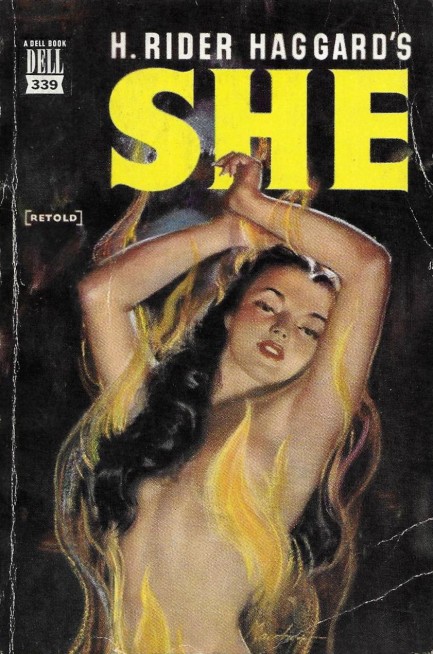
H. Rider Haggard's novel She is one of those rare fantasy/sci-fi novels that has been widely read through three different centuries. A pre-pulp novel, it was originally published in 1887, retained popular interest through the pulp era when it was made into a 1935 movie starring Helen Gahagan, continued generating interest through the mid-century paperback era and into the 1960s, when it was adapted with Ursula Andress in the lead role, and remains available in bookstores and from digital booksellers in the 2020s. The book has enjoyed such longevity because it's a well-written and archetypal lost world adventure with all the elements that sub-genre requires: intrepid explorers in an exotic land, savage encounters with locals, a central quest for something thought to be priceless or unobtainable, and a temptress at the center of the narrative.
The temptress, Ayesha, is an ancient but youthful countenanced woman of Arab descent who has discovered the secret to long life, but who's lost her true love along the way and awaits his reincarnation. She lives in a lost realm called Kôr amidst a host of Africans, who she hates, but rules while she pines for her dead lover to return. Two thousand years after his death, his direct descendant undertakes an expedition to the African interior, where he and Ayesha are destined to meet. This descendent, Leo Vincey, accompanied by his mentor and friend Horace Holly, has been handed down a story through the generations of an immortal woman who murdered his forebear. His quest is to find if such a fantastic story can be true, and possibly take revenge for his entire bloodline.
Haggard is good with descriptive passages, but what's equally interesting is that the book is partly procedural in nature, with long transcriptions of Latin, Arabic, and Greek, and an abundance of academic discussion. Eventually the tale centers around Ayesha's belief that Leo Vincey is her dead lover returned to her, which means her African vigil is mercifully at an end. Her plan? To go to England and rule it with Leo. She'll have to depose Queen Victoria to make that happen, but since she possesses advanced if not magical powers, she considers that no biggie. While we'd have loved to see the story head in that direction, obviously nothing written during the Victorian Age is going to involve a plot to destroy its eponymous figurehead. But what fun that would have been.
On a less fun note, and at risk of stating the obvious, books of this sort are culturally blinkered. The writers depict dark-skinned peoples as savage and deadly, though white-skinned peoples had by then ravaged the entire world, killing hundreds of millions upon hundreds of millions of people for no other reason than greed. This dismissal of non-white lives is exemplified when Horace Holly explains to Ayesha, who hates monarchs, that the nature of royalty has changed during the centuries of her self-imposed exile, and that Queen Victoria is, “venerated and beloved by all right-thinking people in her vast realms.” You have to smile at this, considering the British Empire was an industrial killing machine. Possibly Haggard wasn't aware of that back in 1887, but do any right-thinking people doubt he'd have ignored it even if he'd known?
It's a given that books such as She overlook or deliberately obscure these truths, therefore, if you crack one open, presumably you've made the decision to go along for the ride. While the book's cultural conceits will annoy some readers, it's worth noting that Ayesha's two thousand years of longevity provide Haggard the opportunity to espouse at least a few views unusual for the era, for example when she drops this nugget: “I have long seen that democracies, having no clear will of their own, in the end set up a tyrant and worship him.” Ayesha is Haggard's narrative savior, in our view. She's by far the most engaging character. Though he portrays her as ignorant due to her long sequestration, some of what she says is pretty damn insightful and ironic in 2023. It helps make She a little easier to swallow.
However, the flipside of Ayesha's sometimes intriguing opinions is that she's long-winded. You'd think two-thousand years of life would make her economical with words, but no—the woman can really beat a dead horse. Actually, so can Horace Holly, who narrates via a letter sent to a friend. These aren't dealbreaking flaws, merely ones to be forewarned about. They make the book many pages longer than it need be. And perhaps another small issue is that there aren't many surprises in the story—Holly's narration, being basically epistolary in nature, constantly hints at tragedy, and every plot turn makes a racket galloping at you from a great distance. But She is still good stuff from Haggard, and is a literary landmark for discernible reasons. This edition came from Dell Publications in 1949 with Lou Marchetti cover art.
 Crime capers of the rich and infamous. 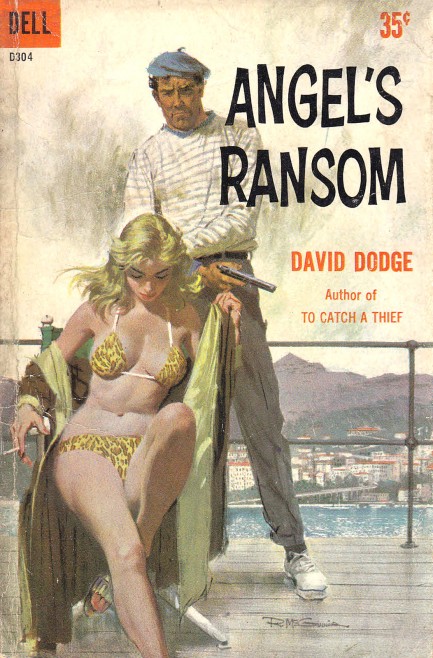
David Dodge's 1956 novel Angel's Ransom takes place in the principality of Monaco, a part of the world the author knew well, along with the rest of the French Riviera. Authentic local details distinguish this kidnapping and ransom thriller, as a group of crooks snatch a yacht called Angel and try to shake down its flamboyantly wealthy owner for 3.5 million francs. Unwillingly along for the ride are the boat's captain, a beautiful guest, a playboy and his distinguished wife, and a Paris showgirl dragged into the plot to assist the criminals. The crooks force the yacht owner to write a bank draft, send a man to Geneva with it, then take the boat out to sea to await word that the draft has been honored. If anything goes wrong, everyone gets to be fish food.
Dodge is a great writer, and this one is good too, though slightly less perfect coming from the master of international intrigue, due to the simple reason that setting most of the action on a boat confines his normally free ranging fiction. But the book is still well written and masterfully paced, with an array of diverse characters to sustain reader interest. If you're going to read any Dodge novel set in this diamonds and champagne milieu we recommend To Catch a Thief—of course—over Angel's Ransom, but you could do far worse than to read any of his international thrillers, including this one. We'll be returning to Monaco with Dodge. He wrote an entire travel book about the French Riviera, ironically titled (because he was a budget traveller), The Rich Man's Guide to the Riviera. We have it and will report back later.
 Hello? Is anybody there? Santa? Is that you? 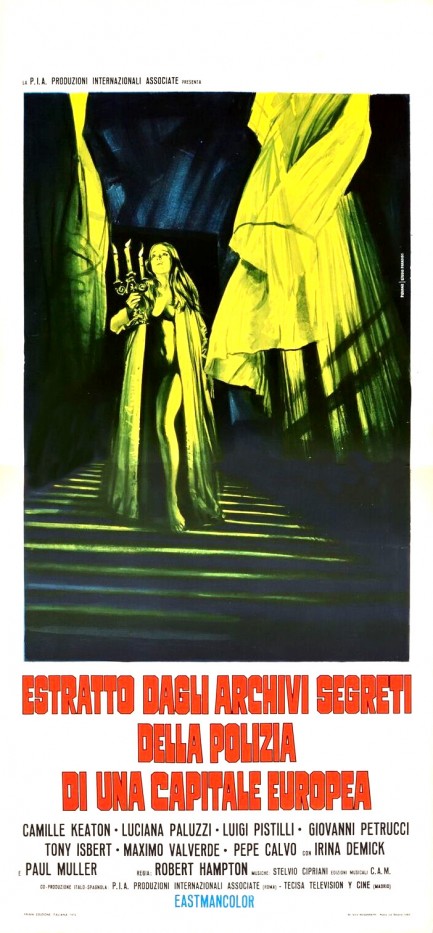
Our sprint through movies this December continues today with the Italian Christmas favorite—Estratto dagli archivi segreti della polizia di una capitale europea, for which you see a festive yule themed poster above. It was painted by Mario Piovano and just oozes holiday spirit. Right. Well, obviously not. This couldn't be a Christmas movie unless Christmas makes you want to kill everyone around you. But it qualifies as a gift from us to you, because we're going to save you the time you might have spent watching it.
The title translates as, “extract from the secret police archives of a European capital,” but was shortened to Tragic Ceremony for its English language release. The Italian title would seem to indicate that this is a giallo flick, but it's actually more in the realm of gothic horror. Basically, a quartet of carefree hippies stumble upon and must survive assorted evils, including a black mass, a phantom gas station, and spurts of megaviolence, all loosely related somehow to a string of possibly cursed pearls.
The movie stars Camille Keaton, who's not well known today, but headlined perhaps the most infamous grindhouse offering of the 1970s—Day of the Woman, better known in some quarters as I Spit on Your Grave. Keaton appears here six years earlier, and is stranded with her hippie-hedonist friends in a creepy old manse where she's seized upon by the loony, aristocratic occupants as a potential sacrifice. She escapes, but the aftereffects of her close call are numerous and gory.
Critics hindered by their own knowledge of niche cinema to the extent that they can't see the forest for the trees tend to describe this movie as underrated, but it really isn't, even if you accept it as a sly commentary on the generational clash between the counterculture and the gentry. At one point a distressed Máximo Valverde asks, “What's happening? What's going on?” Well, you've ended up in a below average horror movie, Max. It happens. Revisionist critics can't help you. Estratto dagli archivi segreti della polizia di una capitale europea premiered in Italy today in 1972.
  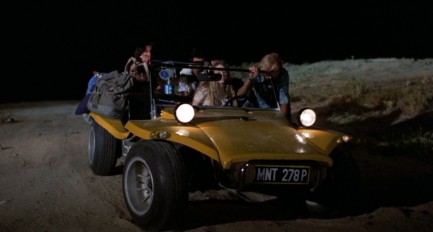           
 I believe you that it's life or death, honey. But believe me it's also life or death that I finish my toes. 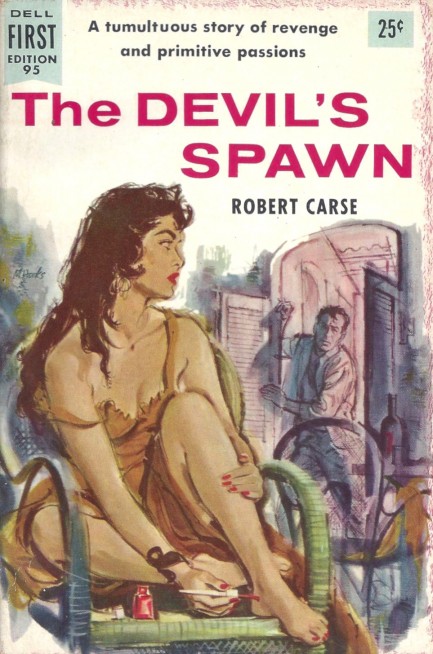
The Devil's Spawn was a random acquisition, a cheap throw-in within a six-book lot. It's a 1956 Dell original with cover art by Mitchell Hooks, was written by Robert Carse, and is a very interesting and unusually graphic tale about an escapee from Cayenne Prison in French Guiana (now Guyana) who lives under a new identity in New York City, but learns that one of the four men he fled with has been targeted by a blackmailer. That means, as the protagonist Jean Prevot puts it, “the trail might be followed down to the next, and the next.” That's exactly what happens, and the blackmailer is from Cayenne Prison, the one person everyone there feared—its sadistic executioner, known as le Bouc.
That's a compelling set-up for a novel, and Carse is an able writer. Especially interesting are his shifts from third-person narrative into second-person deliberations and reveries, without the expected italics to offset the latter from the former. The flow between these passages gives the story an occasional trancelike quality. Also interesting is that Prevot takes intelligent countermeasures. For example, in order to neutralize the blackmail threat, he immediately confesses his past to everyone in his inner circle, most importantly his wife. That's real-world smart, but isn't what most authors would choose. Most would use secrecy as a wedge between Prevot and his loved ones, giving even more initiative to the men who threaten to expose the truth. Carse goes a different way.
But the core of the threat remains even after Prevot brings his inner circle up to speed. Either he does what le Bouc says, or le Bouc informs French authorities that a notorious fugitive—who, by the way, killed a guard during his escape—is alive and well in New York City. If Prevot is caught he'll lose his wife, the lucrative career he's built, and anything resembling a future. That's as far as we'll go in describing the book, except to say that it's a good, gritty ride. Carse will be another one we watch for during our digging for dusty old paperbacks.
 I'll cover his face with the sports section. I think he would have liked that. 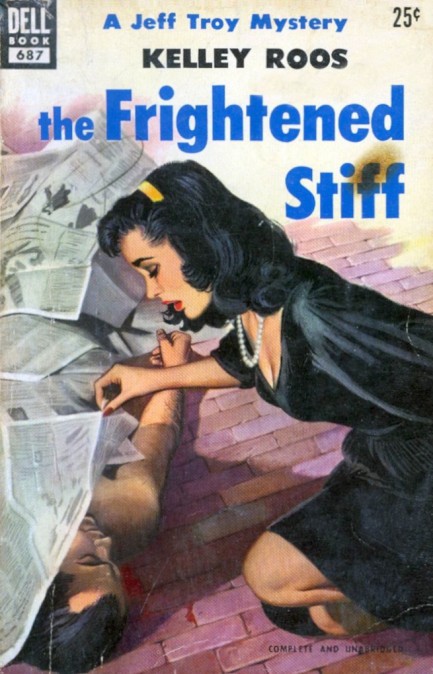
The Frightened Stiff, which was first published in 1944, with this Dell edition coming in 1953, was written by Kelley Roos, and centers on his franchise detective Jeff Troy, who along with wife Haila starred in a run of popular mysteries with a comedic bent. This is the third in the set, with cover art by Len Oehmen.
 Do you ever put the gun away? I'm just wondering because you'll probably need two hands for what I have planned. 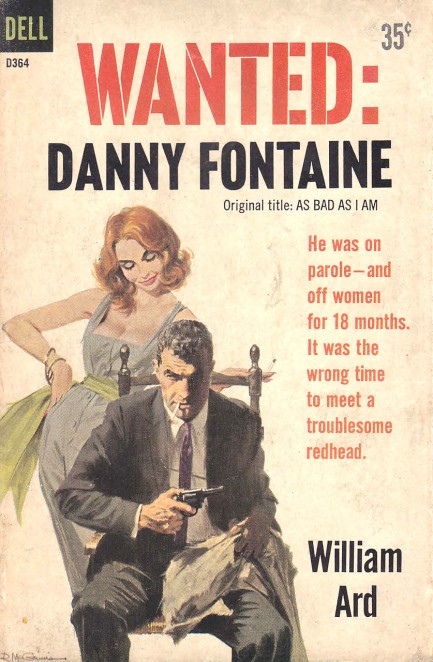
We recently called Barye Phillips a ubiquitous illustrator, but we keep running into Robert McGinnis too. Which mid-century artist do you suppose painted the most paperback covers? Surely both Phillips and McGinnis have to be in the running. Here's the latter's masterful work on the cover of William Ard's Wanted: Danny Fontaine, a 1960 re-issue of 1959's As Bad As I Am. In this novel the title character has just been paroled after his third prison stint. Because his crimes always involve helping damsels in distress, a provision of his parole is that he must stay away from women for eighteen months. That's not easy. He has movie star looks on a six-four frame, and an overt but non-aggressive masculinity wrapped inside a genuine charm that verges on innocence. All of that makes him irresistible to women. But the fact that his probabtion officer can't wait to send him back to prison offers all the motivation he needs to keep his life unentangled.
Unfortunately, Fontaine gets entangled anyway. He gets involved in a cop killing, at which point a beautiful actress named Gloria Allen risks everything to come to his aid. We thought it was a clever thematic reversal by Ard after taking such lengths to portray Fontaine as a habitual white knight. The man who's gone to prison three times rescuing women is doomed unless a woman helps him—and at great risk to herself, since the police have gone full vigilante in an attempt to avenge one of their own. While the plot Ard spins is unlikely in parts, and there are some of the issues regarding race that are endemic to vintage fiction, Danny Fontaine and Gloria Allen are both winning creations, the supporting cast is good, and the story is propulsive. With this one on his ledger, plus the excellent Club 17 and Deadly Beloved, we may have to elevate Ard to our top rank of vintage crime authors, that lofty designation we like to call “trusted."
 Just my luck. I go to the trouble of hiring a bodyguard and end up with one who doesn't even notice my body. 
Hillary Waugh wrote more than forty novels and eventually earned a Grand Master designation from the Mystery Writers of America. His 1958 thriller The Girl Who Cried Wolf shows why, as he takes a standard detective novel premise and adds a touch of girl-crush cuteness to it. A rich co-ed named Patty Merchant has fallen hard for gumshoe Phil Macadam. She's never met him. He gave a lecture to her class and she went starry eyed over him. She hatches a phony stalking story in order to hire him and be close to him, which works fine until she's grabbed by actual kidnappers. The Robert McGinnis cover art on this 1960 Dell edition—and the alternate version below—vibes femme fatale, but Patty Merchant is no man eater. She's shy, sweet, smart in school but a bit clueless in romance. You can't help but like her, and neither can Macadam. Which is good because he goes through the entire wringer and then some trying to locate and rescue her. The Girl Who Cried Wolf is a good, fast paced read, more soft-boiled than hard, but very entertaining. This being our first Waugh, we're already planning to pick up more of his work.
 
 Louis Brennan's disaster thriller is a riddle wrapped in a mystery inside an enigma inundated by a flood. 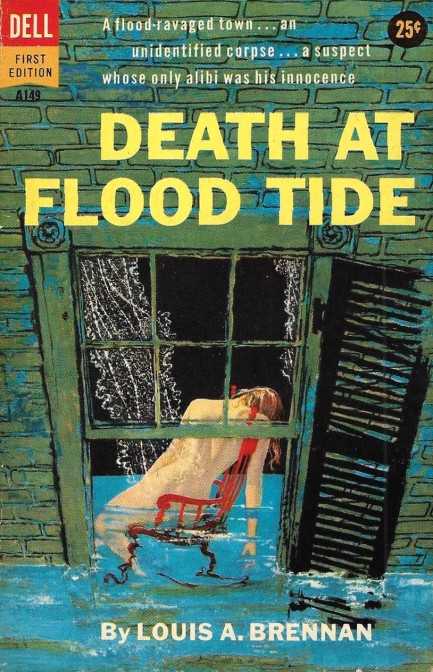
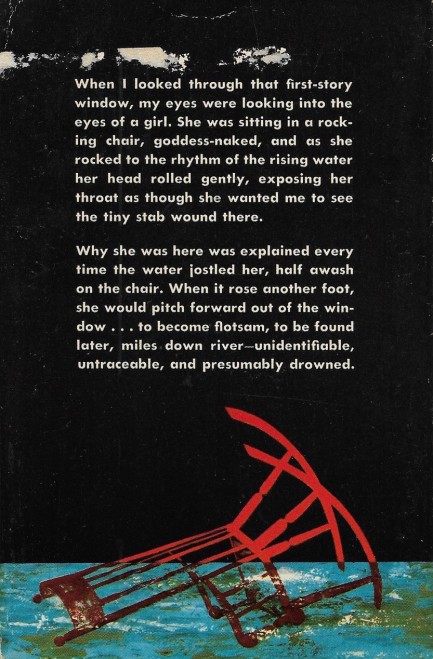 Louis A. Brennan's thriller Death at Flood Tide, first published in 1958 by Dell, has a cover illustration by Bob Abbett, whose work probably needs no introduction. But if he does, look here. This piece is almost on the level of a sketch compared to some of the more realistic scenes he's painted, yet it remains stylistically familiar. Louis A. Brennan's thriller Death at Flood Tide, first published in 1958 by Dell, has a cover illustration by Bob Abbett, whose work probably needs no introduction. But if he does, look here. This piece is almost on the level of a sketch compared to some of the more realistic scenes he's painted, yet it remains stylistically familiar.
The novel tells the story of Barry Coplyn, who during the flooding of an Ohio town is deputized to help the local police, is tasked to follow up the report of a body, finds a nude woman murdered in a house, and subsequently realizes he's suspected of the murder. If he'd simply been arrested he would have had a right to a lawyer and possibly bail, but as a deputy serving the county he has to obey his new boss or be jailed for dereliction of duty. It's a clever gambit by the sheriff to keep Coplyn close and talking while attempting to gather enough evidence to fry him.
The first murder reopens the file on an identical murder two years earlier, and the sheriff thinks Coplyn committed that one too—which is a realization exactly an eternity too late for the man he railroaded into the electric chair. But he isn't too broken up about finding out he was wrong. Instead, he thinks he can make up for the error by sending Coplyn to die—the other man was poor and black, while Coplyn comes from a wealthy white family. This is supposed to balance the cosmic and sociological scales. All of this occurs against the backdrop of the inundated town, with the flood providing hinderances to police, but opportunity to the murderer.
Another interesting aspect of the narrative concerns slaps of the face. Coplyn slaps his girlfriend Jay Jay twice, then spends the entire book trying to excuse this, with none of his explanations remotely adequate. He even wallows in self pity, claiming the slaps hurt him worse than they hurt her. Jay Jay comes to understand she's being unreasonable and forgives him, which we can't condone, but that's the way it goes in mid-century books. In the end she's key to solving the crimes, not through happenstance or device, but through intelligence and insight, so at least Brennan gave her that.
Brennan remains a solid author in this second outing we've taken with him, after the Ohio frontier adventure The Long Knife—though he seems a bit more sure-footed in the old than modern midwest. The main flaw for us is that we had to work hard to like Coplyn and the sheriff, who both suffer from the affliction of callousness portrayed as manliness. We think compassion and restraint show strength, while cathartic emotions like self-pity and fury show weakness, so we were hoping the sheriff would pay for his frame-up, and Coplyn would fail to get the girl. But neither of those outcomes is a possibility. Even so, Death at Flood Tide is pretty good.
 Evelyn Berckman's treasure hunting mystery is a real gem dandy. 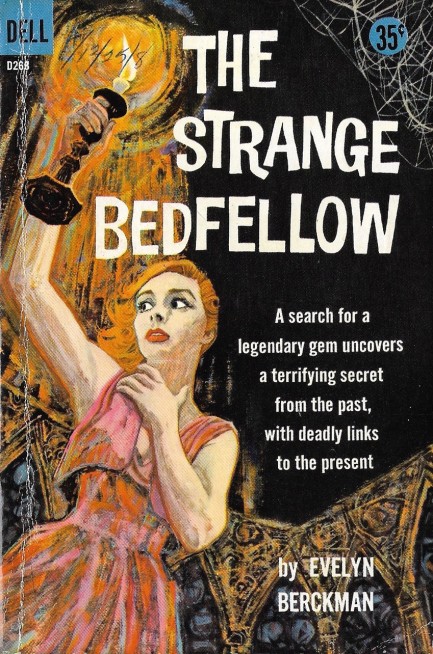
The cover art on this paperback edition of Evelyn Berckman's 1956 novel The Strange Bedfellow was painted by James Hill, and we'll go ahead and call it a masterpiece. We saw brilliant work from him recently on the cover of Thomas Sterling's Murder in Venice, and here his evocative effort gets right to the heart of a story about a museum researcher named Martha Haven beseeched by two older scholars to go on a quest for a priceless ruby called Kali's Eye. The jewel vanished more than two centuries ago in Germany, lost in the aftermath of a crime of passion. While Berckman doesn't necesarily bring anything new to the sub-genre of historical puzzlers, she's an excellent writer:
Incredible that from this passing association—a few words, a kiss or two—she could have become so obsessed with him. At first she had waited, with entire confidence, for the sick longing to lessen, fade away of itself. Far from lessening, it became worse. He was lodged in her like an incurable malady, like a lethal arrow. However she twisted and struggled she could not work it free. So they did happen, those instant, violent attractions of which one read with half-amused skepticism. By a damnable fluke, it had happened to her. She began leading two separate lives. Outwardly she continued doing what she had always done; inwardly she kept walking round and round without ceasing inside a circle of pain.
Love and heartbreak are the key ingredients of romance novels, and as the above passage indicates, there are plenty of love yearnings in Berckman's story, but in addition you get the ingredients of a pulp style treasure hunt: dusty bookstores, old churches, forgotten crypts, desiccated corpses, and the rest. The tale also delves into Jewish history in Europe, which is a harrowing story far beyond the parts most people know casually. Berckman handles all that well, slipping in a few historical lessons, writing from the point of view of a protagonist whose knowledge of what happened back then is spotty. And as a bonus she gets her plot rolling right away with murder on page four.
The book is good, but in our opinion there are two flaws. First, the treasure hunt is too linear—Martha speeds directly to the crumbling medieval hamlet where she thinks Kali's Eye rests, and turns out to be correct. A wrong turn or two would have been nice. And second, Berckman cheats at the climax a bit, relying upon a mechanism rather than Martha's wits to settle matters. An experienced thriller or mystery writer would have dropped Martha in even deeper soup, and invented a cleverer method for her to extricate herself. But neither problem is a dealbreaker. We'd read Berckman again because, simply, good literary skills make up for an awful lot.
 Well, my herb garden died and my macramé is crap. Looks like betrayal and adultery are my remaining options for passing the time. 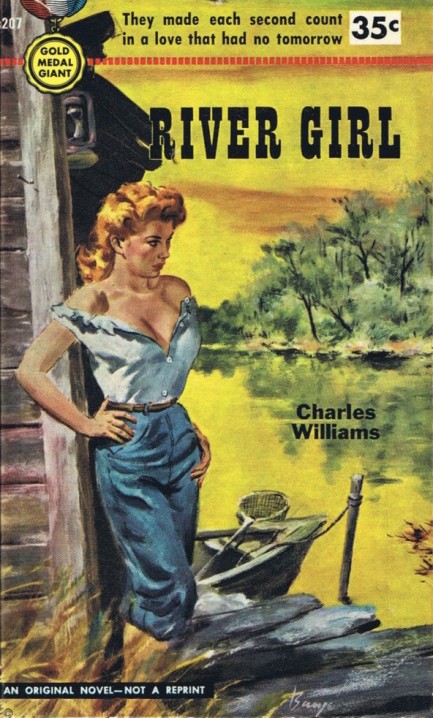
You know what's weird about Charles Williams' 1951 thriller River Girl? There's no river. The action takes place in a swamp, and several sloughs. Sloughs are sluggish side channels. It struck us as funny. Why not call the book Swamp Girl? That would fit both literally and figuratively, because the main character Jack Marshall gets swamped by trouble clear up to his neck. There's a funny line of dialogue about halfway through the book that encapsulates his dilemma. A character muses, “It just doesn't seem possible that in only eleven million years, or however long they've been here, men could have got as stupid about women as they have. They must have practiced somewhere before.”
Yup. What happens here is Jack Marshall, who's deputy sheriff of a southern town, stumbles across a woman living way out in an isolated corner of the local swamp, and is overcome with fascination and lust. We've met these isolated swamp women before in mid-century fiction, and they're always problematic. This one's name is Doris, and Jack wants her real bad, but she lives in a shack with her fisherman husband Roger, the two scratching out an almost feral existence. Why? It seems as if Roger is hiding from either the law, or some shady characters he double-crossed. That's all the opening our horny deputy needs to drive a wedge into the marriage—a dick-shaped wedge. He boats into the swamp to enjoy Doris's company whenever her husband is away, and when she finally agrees to run away with him everything goes wildly, ballistically wrong.
Concerning those ballistics, the hero reflects at one point: “No jury on earth would ever believe I'd had to shoot an unarmed man twenty pounds lighter and fifteen years older than I was just to defend myself. I could have stopped him with one hand.” In the scene, Roger was indeed unarmed, but had moved toward a gun that Marshall reached first. Under identical circumstances, an American cop today could shoot that person—multiple times whether they were unarmed or not—claim to have been afraid, and only an extraordinary set of circumstances would see the cop lastingly punished. But here in 1951 Deputy Do-Wrong is in a real pickle.
There's only one solution: via a complicated gambit he tries to make it look as if Roger has killed him and fled the state with Doris. The key to the scheme is that Roger's body must never be found, nor his own, nor can there be any sign of Doris ever again. Think he can pull it off? Then we've got some prime swampland to sell you at a nice price. Like submerged bodies, complications always pop up. In Williams' hands, those complications provide more than enough dramatic current to make River Girl a fun, swift read. As we've said about him before, he's as reliable as the Woolworth clock. Anything he writes will be at least decent, and often it will be excellent. We rate this one lower than his top efforts, but above what most authors were producing around the same time.
 |  |
|
 |

The headlines that mattered yesteryear.
1974—Police Raid SLA Headquarters
In the U.S., Los Angeles police raid the headquarters of the revolutionary group the Symbionese Liberation Army, resulting in the deaths of six members. The SLA had gained international notoriety by kidnapping nineteen-year old media heiress Patty Hearst from her Berkeley, California apartment, an act which precipitated her participation in an armed bank robbery. 1978—Charlie Chaplin's Missing Body Is Found
Eleven weeks after it was disinterred and stolen from a grave in Corsier near Lausanne, Switzerland, Charlie Chaplin's corpse is found by police. Two men—Roman Wardas, a 24-year-old Pole, and Gantscho Ganev, a 38-year-old Bulgarian—are convicted in December of stealing the coffin and trying to extort £400,000 from the Chaplin family. 1918—U.S. Congress Passes the Sedition Act
In the U.S., Congress passes a set of amendments to the Espionage Act called the Sedition Act, which makes "disloyal, profane, scurrilous, or abusive language" about the United States government, its flag, or its armed forces, as well as language that causes foreigners to view the American government or its institutions with contempt, an imprisonable offense. The Act specifically applies only during times of war, but later is pushed by politicians as a possible peacetime law, specifically to prevent political uprisings in African-American communities. But the Act is never extended and is repealed entirely in 1920. 1905—Las Vegas Is Founded
Las Vegas, Nevada is founded when 110 acres of barren desert land in what had once been part of Mexico are auctioned off to various buyers. The area sold is located in what later would become the downtown section of the city. From these humble beginnings Vegas becomes the most populous city in Nevada, an internationally renowned resort for gambling, shopping, fine dining and sporting events, as well as a symbol of American excess. Today Las Vegas remains one of the fastest growing municipalities in the United States. 1928—Mickey Mouse Premieres
The animated character Mickey Mouse, along with the female mouse Minnie, premiere in the cartoon Plane Crazy, a short co-directed by Walt Disney and Ub Iwerks. This first cartoon was poorly received, however Mickey would eventually go on to become a smash success, as well as the most recognized symbol of the Disney empire.
|

|
|

It's easy. We have an uploader that makes it a snap. Use it to submit your art, text, header, and subhead. Your post can be funny, serious, or anything in between, as long as it's vintage pulp. You'll get a byline and experience the fleeting pride of free authorship. We'll edit your post for typos, but the rest is up to you. Click here to give us your best shot.

|
|

































 Louis A. Brennan's thriller Death at Flood Tide, first published in 1958 by Dell, has a cover illustration by Bob Abbett, whose work probably needs no introduction. But if he does, look here. This piece is almost on the level of a sketch compared to some of the more realistic scenes he's painted, yet it remains stylistically familiar.
Louis A. Brennan's thriller Death at Flood Tide, first published in 1958 by Dell, has a cover illustration by Bob Abbett, whose work probably needs no introduction. But if he does, look here. This piece is almost on the level of a sketch compared to some of the more realistic scenes he's painted, yet it remains stylistically familiar.









































































